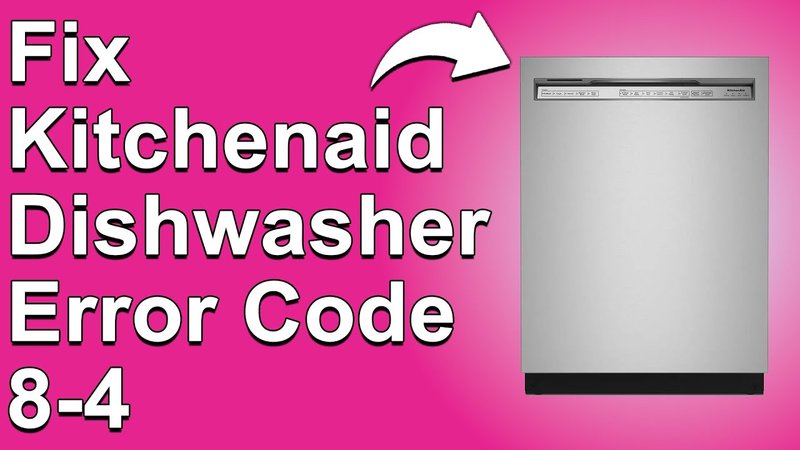
When your dishwasher displays an error code like “LE,” it’s its way of waving a red flag at you. This particular code often signifies a problem with the dishwasher’s motor, which is an essential component in making sure your dishes come out sparkling clean. Ignoring this error is a bit like ignoring the “check engine” light on your car. It may not feel like a big deal now, but it could lead to bigger problems down the road. Let’s dive into what this error actually means and what you can do about it.
Understanding the KitchenAid Dishwasher Error Code “LE”
The “LE” error code is essentially your dishwasher’s way of saying, “Hey, something’s not quite right with my motor.” Just like how a heart pumps blood, the motor in your dishwasher is crucial for circulating water throughout the machine. If there’s an issue with the motor, the water can’t flow properly, which directly affects the machine’s ability to clean your dishes effectively.
You might be wondering why this happens. Common reasons include an overload from stuffing too many dishes in the machine or perhaps an obstruction within the dishwasher itself. Sometimes, it’s as simple as a kinked or blocked water supply hose causing all the fuss. Either way, it’s important to take this signal from your dishwasher seriously. Ignoring the “LE” code might seem convenient, but doing so could lead to increased damage and a heftier repair bill later on.
So, what should you do when you see this code? First, check if the dishwasher is overloaded and remove some items to see if the code disappears. If it persists, it might be time to conduct a more detailed inspection or consider seeking professional help. Taking these steps can help you save time and money in the long run, and ensure your dishwasher remains an efficient helper in your kitchen.
Common Causes of the KitchenAid Error Code “LE”
Now that you know what the “LE” error code means, let’s explore what could be causing it. One of the primary reasons is an overloaded dishwasher. Imagine trying to fit into a pair of jeans two sizes too small — not only is it uncomfortable, but it also restricts movement. Similarly, cramming too many dishes in the dishwasher can overwork the motor, causing it to overheat and trigger the error code.
Another common cause can be a clogged or kinked water line. The water line is like a straw that allows water to flow into and out of the dishwasher. When it’s blocked or twisted, the motor doesn’t receive the necessary water pressure to operate properly. This can be akin to trying to drink through a bent straw — it just doesn’t work well, right?
Lastly, faulty wiring or issues with the motor itself can also trigger the “LE” code. Like the electrical wires running through your walls, these components ensure everything in your dishwasher operates smoothly. If there’s a break or a disconnection somewhere, it can disrupt the machine’s performance. Knowing these causes can help you pinpoint and address the issue more effectively, leading to faster resolutions.
Steps to Address the “LE” Error Code
So, you’ve identified the problem — now what? Thankfully, many of these issues have straightforward solutions. If you suspect your dishwasher is overloaded, start by removing some dishes and running a rinse cycle to see if that clears things up. It’s just like when you give your feet a break after a long day of wearing tight shoes — sometimes, you just need a little relief.
For potential water line issues, inspect the hoses connected to your dishwasher. Make sure there are no kinks, clogs, or breaks. This is similar to checking for a leak in a garden hose — a quick visual inspection often reveals the problem. If everything looks fine and the error persists, it might be time to call in a professional.
Should you need professional assistance, remember that it’s an investment in maintaining a smoothly running home appliance. Ignoring the error is like ignoring a smoke alarm — it might not be a fire now, but it could turn into one if left unchecked. By taking action, you’re ensuring your dishwasher remains a valuable tool in your kitchen arsenal.
Preventing Future Error Codes
No one likes dealing with appliance issues, so preventing them before they start is always a wise choice. Just like regular exercise keeps your body healthy, routine maintenance can keep your dishwasher in top shape. Start by being mindful of how you load your dishes. Avoid overcrowding, as it can strain the motor and lead to future errors.
Periodically check the water lines to ensure they’re free from kinks and clogs. This is much like checking your car’s oil levels — a little maintenance goes a long way. Running a cleaning cycle with vinegar or a specialized dishwasher cleaner once a month can also help keep things running smoothly by breaking down any buildup or debris.
Lastly, stay attentive to any unusual noises or performance issues. Your dishwasher, like any machine, will often give you subtle clues when something’s about to go wrong. By staying proactive, you can catch small problems before they escalate, keeping your kitchen running like a well-oiled machine.
There you have it! By taking these steps and understanding the importance of addressing the “LE” error code, you’re well on your way to a trouble-free dishwashing experience. Remember, it’s always better to tackle these problems head-on and keep your kitchen running efficiently rather than dealing with the hassle of a complete breakdown down the line.